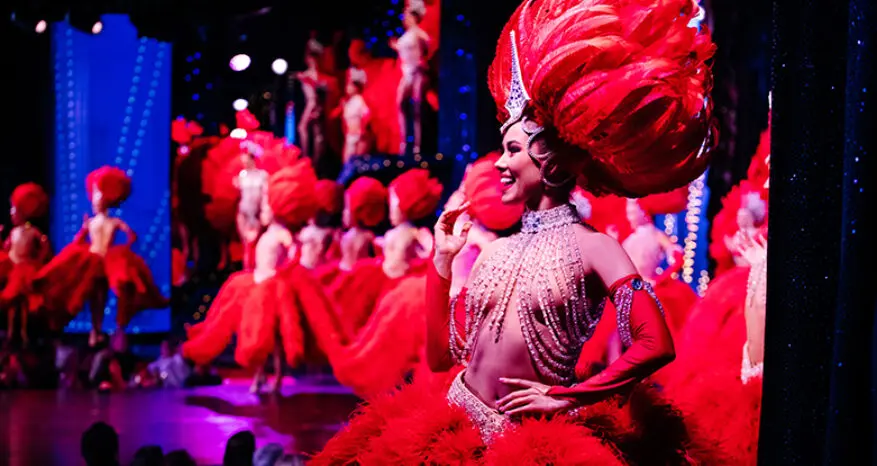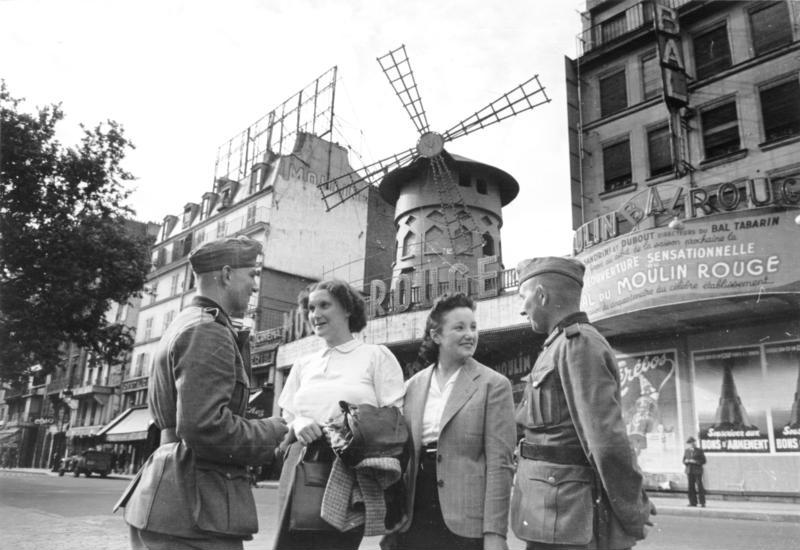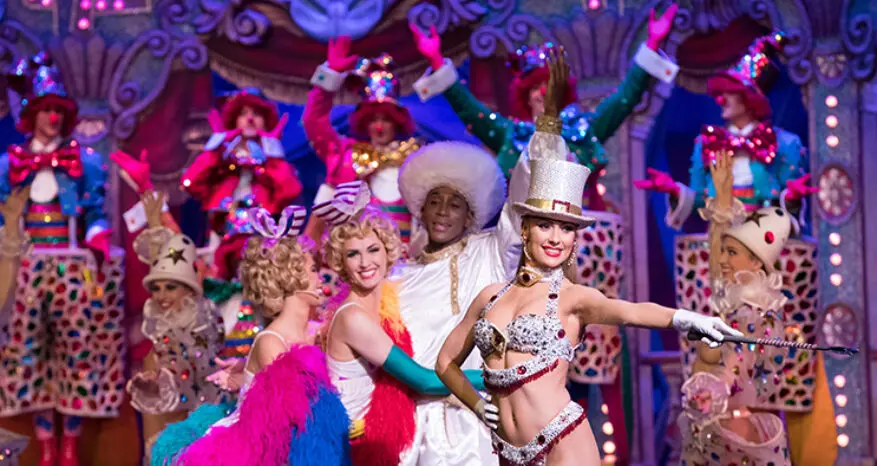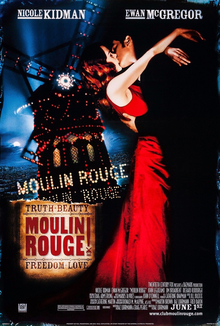
Credit: Moulin Rouge
Perched at the foot of Montmartre, beneath the whirling red sails of its iconic windmill, the Moulin Rouge has long been more than a
cabaret. It is a monument to the wild heart of Paris a space where art, rebellion, seduction, and survival have played out for 135 years.
Born in the glittering chaos of the Belle Époque, the Moulin Rouge became the stage upon which Paris projected its most daring fantasies and
deepest contradictions. From the bohemian cafés of Montmartre to the silver screens of Hollywood, its influence has rippled far beyond the
city’s 18th arrondissement. The Moulin Rouge has weathered world wars, shifting tastes, and global fame without losing its Parisian soul.
This is the story of a windmill that never stopped turning and of a stage that never stopped performing.
At the Foot of Montmartre, a Cabaret Was Born
_1891.jpg) For 135 years, the Moulin Rouge has enchanted Parisian nights. Beneath the crimson
sails of its windmill, perched at the foot of Montmartre, the cabaret has spun a vivid tale of art, scandal, seduction, and transformation.
Opened in 1889 during the heady days of the Belle Époque by impresarios Joseph Oller and Charles Zidler, the venue promised a place “for
people with a refined taste for excitement.” What they created was not just a cabaret, but a revolution in nightlife equal parts spectacle
and social experiment.
For 135 years, the Moulin Rouge has enchanted Parisian nights. Beneath the crimson
sails of its windmill, perched at the foot of Montmartre, the cabaret has spun a vivid tale of art, scandal, seduction, and transformation.
Opened in 1889 during the heady days of the Belle Époque by impresarios Joseph Oller and Charles Zidler, the venue promised a place “for
people with a refined taste for excitement.” What they created was not just a cabaret, but a revolution in nightlife equal parts spectacle
and social experiment.
From the start, the Moulin Rouge defied convention. Champagne flowed freely, classes mingled, and the line between performer and spectator blurred. It was here that the can-can was reborn in its most provocative form, thanks in large part to La Goulue, the audacious, hip-swinging queen of Montmartre. Known for her signature high kicks and unapologetic attitude, La Goulue (real name Louise Weber) became the Moulin Rouge’s first true star, immortalized by Toulouse-Lautrec in a series of now-iconic posters. She was soon joined by other larger-than-life figures: Jane Avril, ethereal and melancholic; Valentin le Désossé, the rubber-limbed contortionist; and a parade of acrobats, clowns, and courtesans who gave the venue its electric pulse. The cabaret quickly became a symbol of Parisian nightlife sensual, subversive, and unapologetically extravagant. More than just a tourist attraction, the Moulin Rouge is a cultural institution, a survivor of wars, and a temple of performance that helped shape the modern identity of Paris.
Fire, Reinvention, and Mistinguett's Era
In 1915, a fire destroyed the original venue, silencing the music and casting uncertainty over its future. However, by 1921, the Moulin Rouge had been reborn. The new structure embodied Art Deco elegance and theatrical ambition, featuring a grander stage and an updated artistic direction.
It was here that Mistinguett took the reins. Already a national icon, she brought her extravagant flair to the revived cabaret. Her revues, such as La Revue Mistinguett, featured enormous casts, inventive sets, and costumes so luxurious they rivaled opera productions. Mistinguett herself was an electric presence, a performer who could embody both the saucy charm of Montmartre and the polished glamour of the Champs-Élysées. With her famous million-franc legs insured by Lloyd's of London, Mistinguett turned the cabaret into a spectacle of French femininity and theatrical imagination. Under her direction, elephants marched through the theater, fountains erupted onstage, and the line between illusion and reality dissolved in a haze of sequins and footlights.
The Moulin Rouge During World War II

Credit: Wikipedia
But even legends reach moments of reckoning. In 1940, as Paris fell under German occupation, the Moulin Rouge stood at a crossroads. Its glittering stage, once a space of liberation, now faced an uneasy reality. Like many institutions in occupied France, it had to navigate the delicate line between survival and collaboration. Entertaining Nazi officers was a moral gray zone, but for the dancers, singers, stagehands, and cooks, it also meant keeping a roof over their heads and food on the table.
The cabaret, stripped of its flamboyant defiance, stayed open its windmill still turning, though more slowly. Onstage, every performance was freighted with tension. A provocative lyric or a subtle gesture could be read as resistance. Surveillance was constant. Risk was real.
By the time liberation came in 1944, the Moulin Rouge had endured. Its spirit had changed, its audience transformed, but its doors had remained open. That wartime chapter, shadowed by compromise and quiet resilience, became part of its layered history, a reminder that even in the darkest moments, the show, somehow, goes on.
A New Era of Glamour

Credit: Moulin Rouge
After the war, the Moulin Rouge was still standing but the world around it had changed. The Belle Époque was long gone, and so was the carefree spirit that once defined the cabaret. Paris was recovering from years of fear and hardship. Mistinguett, one of Moulin’s most beloved stars from before the war, returned to help revive its magic. But rebuilding was not easy. The red windmill, once a symbol of freedom and joy, now felt like a memory from another time.
In the late 1940s and 1950s, the cabaret began to sparkle again. Paris was healing, and people were hungry for light, music, and color. The Moulin Rouge delivered with bold new shows featuring dazzling costumes, updated choreography, and modern stage design. Legendary performers like Édith Piaf and Charles Trenet graced the stage, bringing new energy and emotion to the cabaret’s revival.
As the decades went on, the Moulin Rouge grew into an international sensation. It was no longer just a Parisian treasure it had become a global icon. American stars such as Frank Sinatra, Liza Minnelli, and Elton John were drawn to its mystique and magic. One of the most meaningful returns was that of Josephine Baker, the American-born dancer and French resistance hero. Her postwar performance at the Moulin Rouge marked a powerful comeback and reminded the world of the cabaret’s enduring spirit.
Today, the Moulin Rouge continues to dazzle tourists and Parisians alike. Its famed revue Féerie features more than 60 performers in 1,000 hand-sewn costumes, complete with feathers, rhinestones, and high kicks in the classic can-can tradition. The choreography remains rooted in tradition but infused with theatrical innovation, reflecting the cabaret’s ability to adapt without losing its identity.
Pop Culture’s Favorite Cabaret
 The Moulin Rouge has long captivated filmmakers, artists, and musicians. John Huston’s 1952 biopic Moulin Rouge,
starring José Ferrer as Toulouse-Lautrec, earned seven Academy Award nominations and helped introduce the venue to American audiences. In
the decades that followed, the cabaret became a cinematic shorthand for Parisian decadence.
The Moulin Rouge has long captivated filmmakers, artists, and musicians. John Huston’s 1952 biopic Moulin Rouge,
starring José Ferrer as Toulouse-Lautrec, earned seven Academy Award nominations and helped introduce the venue to American audiences. In
the decades that followed, the cabaret became a cinematic shorthand for Parisian decadence.
Then came Baz Luhrmann’s Moulin Rouge! in 2001. Starring Nicole Kidman and Ewan McGregor, the wildly stylized musical reimagined the cabaret as a pop-fueled fever dream of doomed romance and creative freedom. Its fusion of contemporary music with Belle Époque aesthetic captivated a new generation, turning the name “Moulin Rouge” into shorthand for emotional spectacle. The film earned eight Academy Award nominations and cemented the cabaret’s place in global pop culture.
The cabaret has also featured prominently in music videos and photo shoots. Madonna referenced it during her "Material Girl" era, while Beyoncé posed beneath its windmill for a Vogue shoot. Countless fashion houses, including Chanel and Louboutin, have drawn upon its aesthetic of opulence and femininity for campaigns. More recently, the venue has appeared in pop culture phenomena like Emily in Paris, maintaining its position as a symbol of Parisian fantasy and allure
From Montmartre to Broadway and Beyond
.jpg)
In 2019, Moulin Rouge! The Musical opened on Broadway, bringing the Parisian cabaret’s legacy into the 21st century. Adapted from
Baz Luhrmann’s 2001 film, the Tony Award-winning production transforms the story into a spectacular stage experience. Directed by Alex
Timbers, with a book by John Logan and choreography by Sonya Tayeh, the musical reimagines the original’s bold energy with theatrical flair
and contemporary style.
A vibrant blend of romance, tragedy, and high-octane glamour, the show features a dazzling medley of pop hits from artists like Lady Gaga, Elton John, Beyoncé, Adele, and more. With its opulent sets, dazzling costumes, and emotional storytelling, Moulin Rouge! The Musical has captivated audiences worldwide, earning 10 Tony Awards including Best Musical.
Following sold-out runs in New York, London, and Melbourne, the show is now touring internationally. In 2025, it arrives in Silicon Valley, where Moulin Rouge! The Musical will take the stage at the San Jose Center for the Performing Arts from July 8 to 13. For West Coast audiences, it’s a rare chance to experience the magic of Paris’s most iconic cabaret, no passport required.
🎟️ For tickets and showtimes, visit:
Broadway San
Jose – Moulin Rouge! The Musical
🎁 Want to see the show for free?
The Alliance Française Silicon Valley is giving away two tickets to the July
8 opening night performance at the San Jose Center for the Performing Arts.
Enter the giveaway by July 1, 2025, and experience the glamour, music, and magic of Paris—right here in the Bay Area.
Enter now and learn more:
AFSCV.org
– Moulin Rouge Giveaway & Event Info
🎥 Watch the official trailer:
Enter your content here
Tuesdays 2-6pm
Thursdays 10am-2pm
Saturdays 10am-12pm
Closed on Saturday November 1st
Alliance Française Silicon Valley
Los Gatos, CA 95032
Leave a Comment